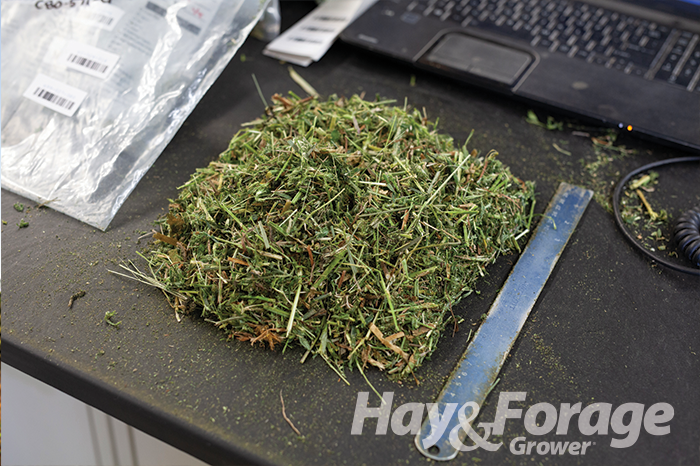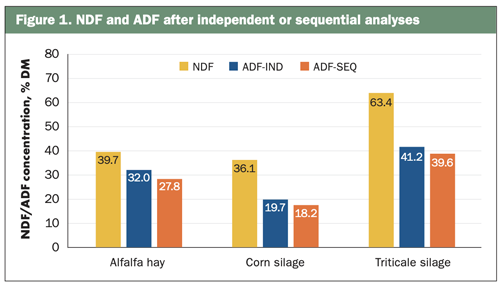
Have you ever seen a forage analysis report where the concentration of acid detergent fiber (ADF) in a forage sample was similar or even greater than the concentration of neutral detergent fiber (NDF)? If so, you have likely wondered how such a thing is possible.
Although unusual, we can find an ADF concentration similar to or greater than the NDF concentration in some forage analysis reports. Some of the limitations of the detergent system used in forage analyses can explain this outcome.
Methods matter
Various analytical methods exist to measure analytes or constituents of interest in a forage or feed sample. These analytes may include specific elements or molecules like nitrogen, calcium, glucose, or amino acids. Among the various analytical methods, rational or theoretical methods are used to quantify an identifiable analyte.
Here’s an example: When we want to quantify glucose, the analytical technique can identify glucose and ensure that glucose is the entity quantified. On the other hand, empirical methods quantify substances or residues that are not specific. Therefore, the results of the empirical methods depend heavily on the protocol utilized for quantifying these nonspecific residues.
A clearer example of this is lignin. Generally speaking, we tend to refer to lignin as an unambiguous term. However, at least three methods exist for quantifying lignin, including the acid detergent lignin (ADL), the acetyl bromide lignin (ABL), and the Klason lignin. All these methods will likely provide different answers when a single forage sample is analyzed. How is this possible? It is because methods vary, and the amounts of the resulting residues of these methods differ.
Coming back to the original question, both NDF and ADF methods in the detergent system of forage analysis are empirical methods. As such, their results vary depending on how we perform these methods.
It doesn’t add up
Generally speaking, NDF includes hemicellulose, cellulose, and lignin, whereas ADF includes only cellulose and lignin. Therefore, we should expect a concentration of NDF greater than the concentration of ADF because NDF has hemicellulose in addition to the components of ADF. Understanding the limitations of analytical methodologies may help explain a contradicting outcome. At least four reasons exist for these odd observations.
One reason for having greater ADF concentration than NDF concentration could be related to the contamination of the sample with inorganic matter. When the NDF residue is subjected to combustion to obtain NDF corrected for organic matter (aNDFom), a substantial drop in NDF concentration can be observed after combusting or ashing the residue. If the ADF method does not similarly correct for organic matter, the inorganic matter may remain in the ADF residue, overestimating the ADF concentration. To overcome this issue, it is important to correct the organic matter in both NDF and ADF procedures.
A second reason for having a greater ADF concentration than NDF concentration could be related to the partial solubility of pectin in acid detergent. When we perform NDF and ADF analyses independently, the pectin excluded from the residue during NDF analysis may be included in the residue during ADF analysis, which would consequently overestimate the ADF concentration of the forage. To solve this issue, perform an ADF analysis on the resulting residue of NDF analysis, also known as sequential analysis of ADF after NDF. However, because the NDF residue is not subjected to combustion for organic matter correction, these sequential analyses should be replicated exclusively to correct for organic matter.
The solubility of tannins in the neutral detergent is a third reason for having a greater ADF concentration than NDF concentration. Tannins are polyphenolic compounds that are soluble in neutral detergent — at least partially — but not in acid detergent, so these tannins would underestimate the NDF residue. To overcome this, difference sequential NDF and ADF analyses might be warranted.
Finally, the use of sodium sulfite in the NDF analysis can solubilize some of the polyphenolic compounds of lignin that remain in the ADF residue. Either the removal of sodium sulfite or a sequential NDF and ADF analysis could be performed to solve this issue.
Alfalfa was variable
At the Dairy Forage Research Laboratory at Virginia Tech, we evaluated the impact of performing NDF and ADF independently and sequentially on samples of alfalfa hay, corn silage, and grass hay. In the case of corn silage and grass hay, the difference in ADF concentrations between the independent and sequential analyses was minimal (less than 2 percentage units of ADF). However, in the case of alfalfa hay, the difference in ADF concentrations between independent and sequential analyses was more pronounced (4.2 percentage units).

This article appeared in the August/September 2025 issue of Hay & Forage Grower on page 10.
Not a subscriber? Click to get the print magazine.
